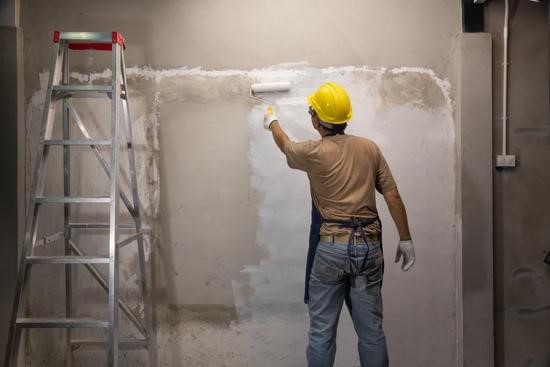Many people who decide to paint their own homes have trouble telling the difference between primer and ceiling paint.
It is always a good idea to consult an interior house painting specialist to assist with any questions
People sometimes utilize their ceiling paint leftovers as a primer, which means they put a coat on the wall before applying the colored paint because ceiling paint always has a matte surface. But did you know that the qualities of latex interior paint, which you often use to paint walls, are the same as those of ceiling paint?
If you think you might be related, a blog post might be useful; keep reading.
Table of Contents
Is It Safe To Ceiling Paint As Primer?
Yes, one can use ceiling paint as a primer on the room’s walls or even when painting vaulted ceiling or other ceilings. However, you must understand your walls and paint’s texture before painting it over ceiling paint primer. Thousands of professionals and painters have tested it, especially when they don’t have the time or resources to go to the hardware store.
Instead of throwing leftover ceiling paint in the trash, folks found a more cost-effective approach that produces superior results.
If you want to use the ceiling paint as a drywall primer, you will need to apply many coats to adequately cover the material, which could be time and energy-demanding. Because drywall is porous, it absorbs paint like a sponge.
If you desire a seamless, flat appearance, ceiling paint can be used on the interior walls of your home. Ceiling paint has a plethora of advantages. If you follow up with a higher gloss finish, ceiling paint can also be used as a primer for walls, doors, and trim.
Understand The Difference Between Ceiling And Wall Paints
The viscosity of the paints is the most important variation between them. Ceiling paint is thicker because it has a higher viscosity. When it’s applied, this characteristic helps it adhere better. The paint contains more solids when you use a roller so that it won’t splatter or drip as much. As a result, ceiling paint applies more smoothly.
Ceiling paint’s viscosity also makes it an excellent primer for walls. It’s simple to cover any high-traffic part of the house or any location with mildew stains due to poor ventilation. Let’s discuss a few main facts that make wall paint different from Ceiling paint:
Paint Coverage
A single coat of paint provides far better coverage than the two or three coats required by wall paint. Scuffs and other wall markings can be hidden with a higher covering. You can also get the task done with less paint.
A flat, glossy finish is typical of ceiling paints. This indicates that the paint has little to no refractivity. The ceiling would be overshadowed with a reflecting or high-gloss coating. On the other hand, flat white paint complements all sorts of the ceiling. Flat paints are frequently used on the ceiling and walls in a modern office setting.
Paint Durability And Coloring Options
Ceiling paint isn’t available in a wide range of colors because ceilings are often homogeneous and unadorned. Ceiling paint colors are limited in comparison to wall paint colors. To acquire the desired color, you can have the paint blended at your local paint shop.
Flat paints are more durable than semi-gloss or high-gloss paints. Hence, they’re commonly used on ceilings. If your walls are prone to scratches or scuffs, a coat of flat paint along the wall’s surface can extend the life of the paint.
Paint Pricing Also Matters
You might be able to save money by painting your walls with ceiling paint. On average, the paint is less expensive than most interior paints. If you’re re-painting the entire interior, using ceiling paint as a primer could save you money on additional products.
You’ll save money on wall paint because of the coverage and ability to disguise wall marks in a single application. On the other hand, Ceiling paints can be more expensive than latex wall paint.
Use White Paint As Primer Paint On The Walls
Ceilings can be painted using the same paint that is used on walls. Regular wall paint, on the other hand, has a lower viscosity. More messes and drips may result from the reduced viscosity. To achieve the greatest results, make sure that the paint sheen on the ceiling and walls is the same.
A matte finish or sheen is present in flat white and ceiling paint, resulting in a smooth, homogeneous texture and look. Even if it isn’t labeled, you can use flat white interior latex paint on ceilings. On the other hand, Ceiling paint is a smoother procedure because it has fewer spatter and drips. Additionally, ceiling paint hides flaws better.
Final Thoughts
Hopefully, this information will assist you in receiving a suitable response to the issue “Can you use ceiling paint as a primer?” According to our guidelines, using ceiling paint as a primer is not always a good idea. It’s not that they won’t work, but priming using a primer is much more effective.
If you have a gallon of primer in your garage or some money to spend on a new gallon, we’d recommend sticking with it rather than experimenting with something that isn’t as trustworthy.
Ceiling paint is sometimes used as a primer in modern interior design to create texture in living and dining rooms and home offices. It’s also great for concealing scuffs and blemishes.





